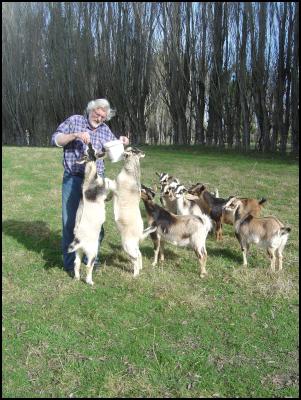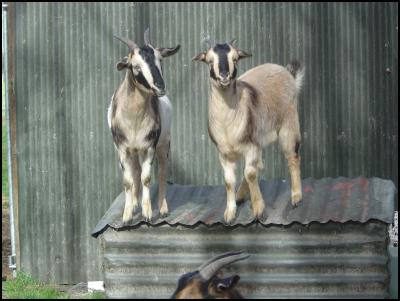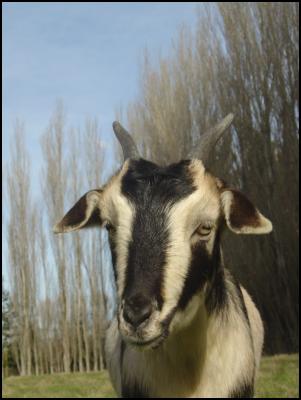New move to save the unique goats of Arapawa Is
MEDIA RELEASE
February 28, 2008
New move to save the unique goats of Arapawa Island

Click for big version
Time is running
out for the unique goats of Arapawa Island, as a DOC cull
looms.
In response, a group of concerned rare breeds enthusiasts from around New Zealand, the UK and the USA have come together to try to raise enough money to rescue as many goats as possible before the cull takes place in March.
The money will be used to help Betty Rowe of the Arapawa Wildlife Trust (and island resident) to repatriate as many animals as possible, to save their unique genetics which are found nowhere else in the world.
While the Arapawa Island goat isn’t a native animal of New Zealand, it is an endangered breed only found here. It is thought that the goats originate from a few left by Captain James Cook on visits to NZ in 1773 and 1777. It may be with more DNA testing that the goats can be shown to be ancestors of the now extinct Old English Goat, a breed that died out in the UK in the 1950s.
Betty’s Wildlife Trust already provides a sanctuary to approximately 50 of the goats, but the more goats that can be saved, the more genetics will be available for breeding for future generations. The total number of goats worldwide is believed to be approximately 360, with a precious few exported to rare breed enthusiasts in the UK and USA to help protect their genetics if NZ ever has a biosecurity threat such as Foot and Mouth.

Click for big version
While DOC’s mission is
to protect the unique flora and fauna on the island’s
reserve, Betty and many rare breed supporters around the
country have been trying to persuade DOC to give them time
to round up as many as possible for rehoming to the mainland
where enthusiasts have volunteered to take them on. However,
despite repeated requests DOC will not enter into a
dialogue, only saying they have done a formal head count by
helicopter, although they won’t release any details of
it.
“New Zealand is a signatory to the Rio Convention, which we signed in 1992, and as such it obligates us to a Biodiversity consideration,” says Betty. “The old cry of "destruction to native flora" cannot be upheld, as the island where the goats are in residence, is regenerating. This began with the cessation of most sheep farming on the island some 10 years ago.”
“I might add that back in 1977 when the Forest Service came to the island to begin shooting, we had an upswelling of angry people who trudged up the hill and back down again every night for two weeks, putting themselves between the shooters and the goats. It was a beautiful moment of compassion.”

Click for big version
“However, at 76, I
cannot now lead a charge up the hill and am endeavouring to
find a way to keep the few fragmented groups of these goats
who represent part of our history and heritage and are a New
Zealand taonga (treasure) from being further decimated.”
DOC originally planned a cull – without informing any of the Arapawa Island goat supporters – in January this year. An outcry at the time got that postponed until March.
Despite repeated requests to DOC by Betty Rowe to have meetings and try to sort out an alternative solution, such as rehoming, DOC do not appear to want to find any solution other than a cull.
Repeated offers to DOC to meet and discuss the possibilities of capturing and rehoming the goats have met with stony silence. Betty and her volunteers have a number of people around New Zealand offering homes and help in rehoming any goats. Despite this offer being put before DOC several times, they still remain silent and one can only wonder why there seems to be reluctance on their part to follow this up? Requests to have an independent headcount of the animals in the DOC controlled areas have been ignored.
DOC claim they have done a recent headcount by helicopter but will not release details of what that head count is and therefore numbers cannot be verified at this time. Betty has been told by a source close to DOC, that DOC officials climbed up a hill and saw 5 goats, and apparently heard 5 more goats. If this is their way of officially “counting” the number of goats, then it is not a very professional way of doing so.
How to help
If you can spare just $1 it would make a huge difference to the work Betty (and her many supporters) can do. It would give Betty and the goats a fighting chance and would be used to either rehome (where possible) as many goats that can be caught and repatriated to those people who have put their hands up to offer them sanctuary.
Donations can be made as follows:
You can make a donation directly to Betty Rowe’s Charity Trust. Cheques should be made out to Arapawa Wildlife Sanctuary, and can be sent care of Betty Rowe, Arapawa Wildlife Sanctuary, Private Bag, Picton.
Arapawa Island goats – DNA research
The following information comes from Betty Rowe and can be used as quotes from her.
“The Arapawa Island Goats have recently had DNA analysis presented by D.P Sponenberg, DVM,PhD, Professor of Pathology and Genetics, Virginia-Maryland Regional College of Veterinary Medicine .The work was carried out at the University of Cordoba on behalf of the American Livestock Breeds Conservancy (the ALBC).
“The results indicate that the Arapawa Island Goats, however, are a unique genetic resource when compared with other goat breeds. As such, it warrants continued conservation as a pure population.
More on the analysis can be obtained from Professor Sponenberg at dpsponen@vt.edu
“My own involvement began in 1973 when we began to become interested in the wild sheep on the island. The subsequent visits of scientists to Arapawa Island declared the sheep to be of historical and scientific interest, but condemned the goats and pigs that were also found on the island to a death sentence.
“My own research had shown that goats were left on Arapawa Island by Captain James Cook back in 1773 and 1777 and that Edward Jerningham Wakefield had observed goats at the whaling station which is on Arapawa Island.
“This observation was noted in Wakefield's journals in 1839 when he wrote "the children of the settlement (meaning the whaling station) were as active and hardy as the goats with which the settlement swarmed".”
“I remarked to the scientists that perhaps the other feral animals, ie goats and pigs, should be studied before any extermination plan took place, given that they had been in residence on the island for a very long time. No such study was forthcoming and the battle lines were drawn that continue to this day to try and protect and preserve the now proven uniqueness of the goats.”
“Michael Willis, Director of Willowbank Wildlife Reserve and founder of the New Zealand Rare Breeds Conservation Society and a present Director of Rare Breeds International, organized three separate musters consisting of volunteers to come to the island to bring the goats into the safety of our farm in East Bay.
“The volunteers were few at first with only seven people, but by the third muster we had 50 volunteers and we managed to bring a lot of the goats onto "Aotea", our farm.
“One of the volunteers was a lady from England who identified the goats as Old English. We were told that the Old English goat had died out in a severe winter of 1954. Putting pieces of the puzzle together we had goats left on Arapawa Island centuries ago, either by early settlers, whalers and, according to history books, by Captain James Cook himself. Goats were observed as "swarming "by Wakefield and the goats had been identified as the Old English Goat by an English woman (name unknown) who had a background in goat keeping. The news that the Old English had become extinct seemed to me to form something that, at the very least, required research. However, the authorities would have none of it, dismissing it as the emotional trivia of an ex-pat American woman.
“Years of research was lost in the fire that consumed our home in 1999, but slowly some of it has been recovered as I had shared it with others and they in turn returned copies to me over the years. I have offered to share this research with the Department of Conservation, here in New Zealand and to talk to their scientists and knowledgeable people.
“Just last October, we received confirmation of the uniqueness of the goats, through Prof Sponenberg's analysis. The DNA showed that the goats were a close knit family group that originated from only a few original releases, tying in with the Captain Cook releases of two - three animals or with early settlers on the island. None of the early visitors to Arapawa Island would have had the capacity, nor desire, to release large numbers of goats, and would have left only a small grouping, which is what the DNA tells us.”
“I felt this was exciting news that had at last vindicated the goats and would ensure their survival as the numbers of goats is very low world-wide. I believe we can only account for around 360.
“The goats outside of the Arapawa Wildlife Sanctuary http://www.rarebreeds.co.nz/rowe.html which my late husband and I established and which is now a Charitable Trust, assumed greater significance when we realised we were desperately low in numbers to try to preserve this unique breed
“Due to the over-zealous culling activities of first the NZ Forest Service and more recently the Department of Conservation we could not meet the recommended number of 500 as a viable herd to be retained on the island as a genetic back-up, so I requested DOC work with us to this end.
“The DNA results were ignored by the new Minister of Conservation as had all research by the government's previous ministers been ignored. Instead we were told just a month or so ago that DOC were to arrive on the 7th January 2008 and shoot the goats for three weeks up until the 25th January, excluding weekends.
“This was definitely overkill and I began the campaign to try to stop this yet again.
“New Zealand is a signatory to the Rio Convention which we signed in 1992 and as such obligates us to a Biodiversity consideration. The old cry of "destruction to native flora" cannot be upheld, as the island where the goats are in residence, is regenerating. This began with the cessation of most sheep farming on the island some 10 years ago.
I might add that back in 1977 when the Forest Service came to the island to begin shooting, we had an upswelling of angry people who trudged up the hill and back down again every night for two weeks, putting themselves between the shooters and the goats. It was a beautiful moment of compassion.
“However, at 76, I cannot now lead a charge up the hill and am endeavouring to find a way to keep the few fragmented groups of these goats who represent part of our history and heritage and are a New Zealand taonga (treasure) from being further decimated.
“This is only a part of the whole, but perhaps enough to bring the urgency of the present situation to those prepared to listen.”
Thank you
Betty Rowe
Arapawa
Island
(All photos used in this Press Release have
been reproduced with the kind permission of Jane Buxton
copyright)
ENDS


 Engineering New Zealand: NZ Building System Needs Urgent Improvement
Engineering New Zealand: NZ Building System Needs Urgent Improvement GNS Science: Bioshields Could Help Slow Tsunami Flow
GNS Science: Bioshields Could Help Slow Tsunami Flow Transport and Infrastructure Committee: Inquiry Into Ports And The Maritime Sector Opened
Transport and Infrastructure Committee: Inquiry Into Ports And The Maritime Sector Opened Netsafe: Netsafe And Chorus Power Up Online Safety For Older Adults
Netsafe: Netsafe And Chorus Power Up Online Safety For Older Adults RBNZ: 10 Cent Coin With King Charles III Image Now In Production
RBNZ: 10 Cent Coin With King Charles III Image Now In Production NZALPA: Safety Improves From AKL Incident Learnings
NZALPA: Safety Improves From AKL Incident Learnings


